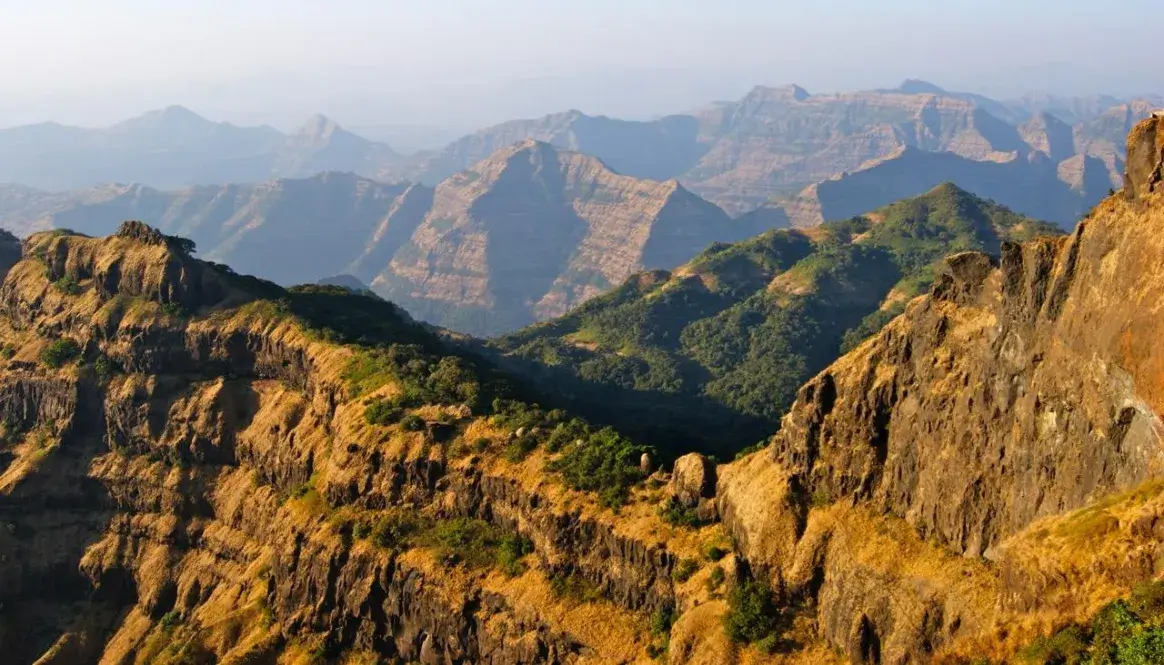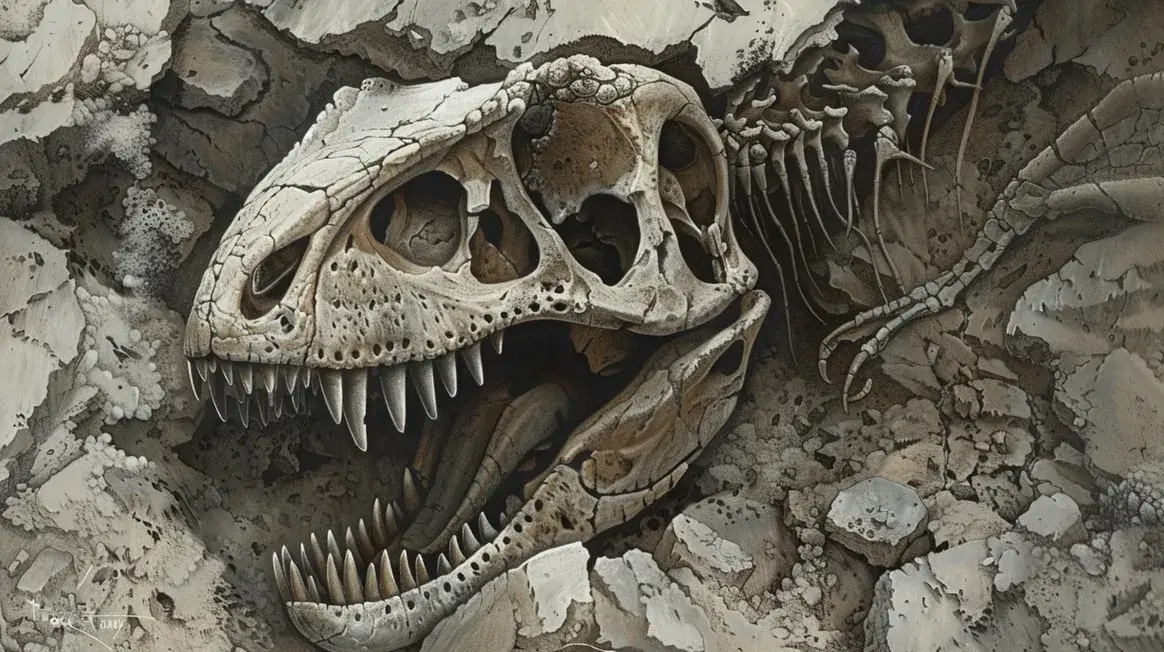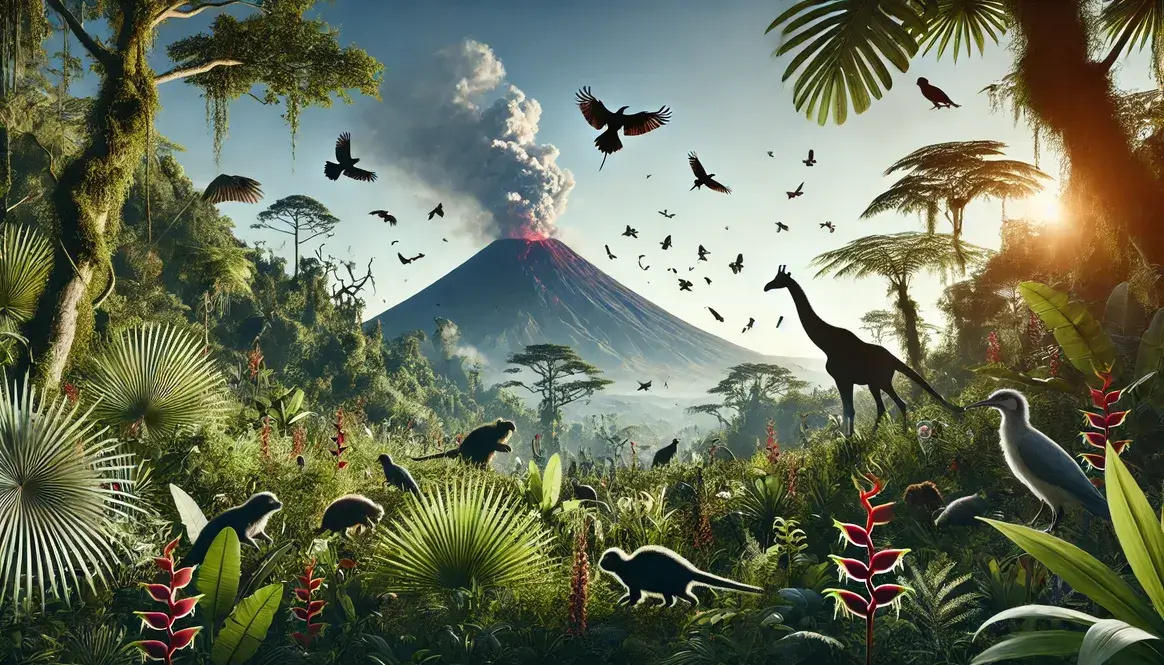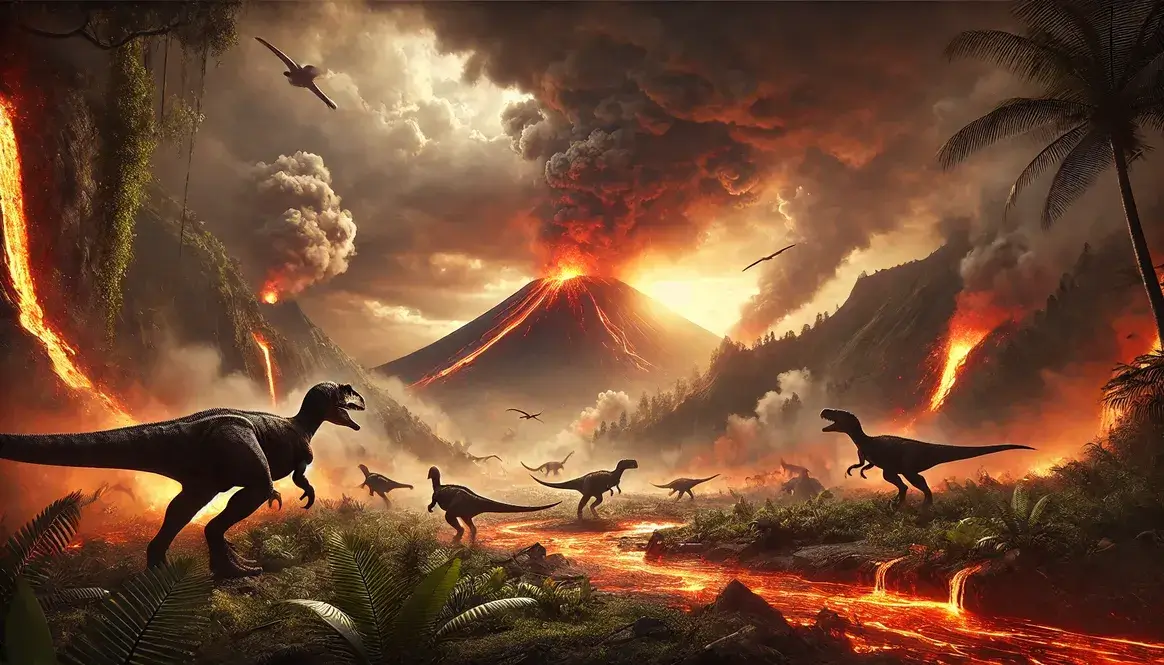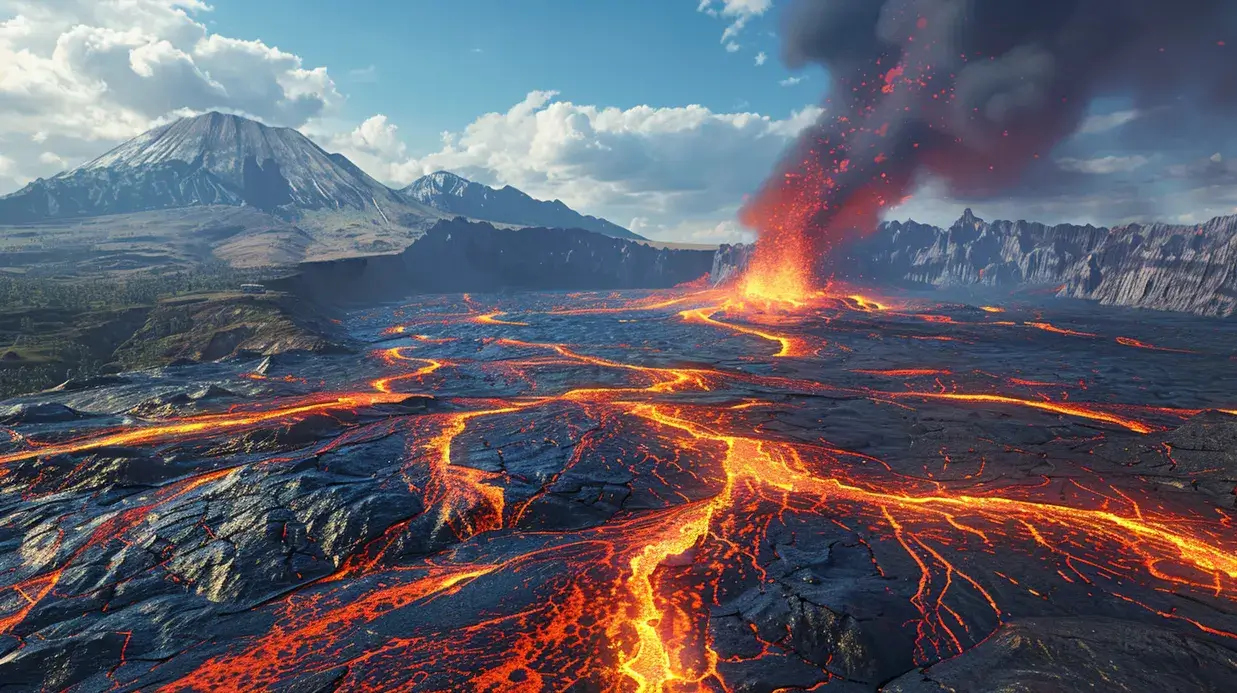| Key Facts About the Deccan Traps | |
|---|---|
| Location | Western India |
| Age | Formed about 66 million years ago |
| Area Covered | Originally 1.5 million square kilometers |
| Volume of Lava | Over 1 million cubic kilometers |
| Type of Formation | Flood basalt (large igneous province) |
| Significance | Potentially linked to dinosaur extinction |
Imagine a place where lava once flowed freely, covering an area bigger than Texas and California combined. That’s the Deccan Traps for you! This huge volcanic area in western India is one of the largest volcanic features on Earth. It’s so big that if you were to stand on one end, you couldn’t see the other side even with the world’s strongest binoculars!
The Deccan Traps formed about 66 million years ago, right around the time dinosaurs went extinct. That’s not just a coincidence – some scientists think these massive lava flows might have played a role in the dinosaurs’ disappearance. But we’ll get to that later!
What are the Deccan Traps?
So, exactly what are the Deccan Traps? Well, let’s break it down:
The Deccan Traps are a huge area of hardened lava in western India. They’re called “traps” because of the step-like hills formed by the lava flows. “Deccan” comes from the Sanskrit word for “south,” referring to the southern part of India where they’re located.
These aren’t your typical volcanoes with cone-shaped mountains. Instead, the Deccan Traps are what geologists call a “flood basalt.” That means they formed when enormous amounts of lava erupted from cracks in the Earth’s surface, flooding the land like a river of molten rock.
Here’s how it happened:
- Cracks formed in the Earth’s crust.
- Massive amounts of lava poured out of these cracks.
- The lava spread out over a huge area, cooling and hardening into layers of rock.
- This process repeated many times over thousands of years.
The result? Layer upon layer of hardened lava, creating the step-like landscape we see today. It’s like a giant layer cake made of rock!
The Deccan Traps are so important that geologists from all over the world come to study them. They help us understand how the Earth works and how big volcanic eruptions can change our planet.
Where are the Deccan Traps Located?
If you’re planning a trip to see the Deccan Traps, you’ll need to pack your bags for India! These massive lava flows are located in the western part of the country, covering a huge chunk of the Deccan Plateau.
The Deccan Traps spread across several Indian states, including:
- Maharashtra
- Madhya Pradesh
- Gujarat
- Andhra Pradesh
But here’s the really mind-blowing part: what we see today is just a fraction of what was once there! Scientists think the Deccan Traps originally covered an area of about 1.5 million square kilometers. That’s about half the size of India itself!
Over millions of years, erosion has worn away much of the original lava flows. Today, the Deccan Traps cover about 500,000 square kilometers. That’s still enormous – imagine 200,000 football fields put together!
The landscape of the Deccan Traps is unique. It’s characterized by flat-topped hills and steep cliffs, creating a step-like appearance. This is why they’re called “traps” – the word comes from the Swedish word “trappa,” meaning stairs.
When Did the Deccan Traps Form?
Now, let’s hop into our time machine and travel back to when the Deccan Traps were formed. Are you ready? Hold on tight!
We’re going back about 66 million years, to the end of the Cretaceous period. This was a time when dinosaurs still roamed the Earth, and the world looked very different from today.
The formation of the Deccan Traps wasn’t a quick event. It took place over a long period, with eruptions happening on and off for about a million years. That’s a really long time – longer than humans have existed!
Here’s a simple timeline of the Deccan Traps formation:
- Start of eruptions: About 66.3 million years ago
- Main phase: From 66.1 to 65.5 million years ago
- End of eruptions: About 65.3 million years ago
During this time, there were periods of intense volcanic activity followed by quieter periods. The most intense eruptions happened right around the time the dinosaurs went extinct. This timing has led some scientists to wonder if the Deccan Traps played a role in the mass extinction at the end of the Cretaceous period.
The eruptions that formed the Deccan Traps were truly massive. They released huge amounts of lava and gases into the environment. These eruptions could have had a big impact on the Earth’s climate, potentially leading to significant changes that affected life all over the planet.
In the next section, we’ll explore just how big these eruptions were. Get ready for some truly enormous numbers!
The Incredible Scale of the Deccan Traps
Get ready to have your mind blown by some seriously big numbers! The Deccan Traps are so huge that they’re hard to imagine. Let’s break it down into smaller pieces to help us understand just how massive these lava flows really are.
Area Covered
Imagine you could spread a giant blanket over western India. That’s kind of what the Deccan Traps did, except with lava instead of fabric!
Originally, the Deccan Traps covered an area of about 1.5 million square kilometers. That’s bigger than:
- The entire country of Mongolia
- All of California, Oregon, and Washington combined
- About half the size of India itself!
Today, due to erosion over millions of years, the Deccan Traps cover about 500,000 square kilometers. That’s still enormous – it’s larger than the entire country of Spain!
Volume of Lava
Now, let’s talk about how much lava erupted to form the Deccan Traps. Brace yourself, because these numbers are truly mind-boggling!
Scientists estimate that the total volume of lava erupted was over 1 million cubic kilometers. That’s enough to:
- Fill up 400 million Olympic-sized swimming pools
- Cover the entire Earth with a layer of lava 3 meters deep
- Build a stack of lava cubes each 1 km on each side, reaching from Earth to the Moon!
This massive outpouring of lava had a huge impact on the environment. It released enormous amounts of gases into the atmosphere, which could have led to significant climate changes. Some scientists think this might have played a role in the extinction of the dinosaurs.
Thickness of Lava Flows
The Deccan Traps aren’t just wide, they’re also incredibly thick. The lava flowed and cooled in layers, building up over time to create the step-like hills we see today.
| Lava Flow Thickness | Measurement |
|---|---|
| Average Thickness | 1,500 meters |
| Maximum Thickness | 2,400 meters |
To put this in perspective:
- The average thickness is about as tall as 5 Eiffel Towers stacked on top of each other!
- The maximum thickness is like stacking 8 Eiffel Towers!
Some individual lava flows were incredibly thick too. The thickest single flow found so far is about 400 meters thick. That’s taller than the Great Pyramid of Giza!
These thick layers of lava have preserved a lot of information about the Earth’s past. Scientists study the volcanic ash in fossils found in these layers to learn more about the ancient environment and the creatures that lived there.
The sheer scale of the Deccan Traps is a testament to the incredible power of our planet. In the next section, we’ll explore how these massive lava flows formed. Get ready to dive deep into the Earth!
How the Deccan Traps Formed
Now that we’ve seen how big the Deccan Traps are, let’s dive into how they formed. It’s like unwrapping a giant, fiery present from Earth’s past!
The Mechanism Behind Flood Basalts
The Deccan Traps are what geologists call a “flood basalt.” But what does that mean? Well, it’s not the kind of flood you might see after heavy rain. Instead, it’s a flood of lava – and a really, really big one at that!
Here’s how it works:
- Deep Earth Rumbles: It all starts deep beneath the Earth’s surface. Hot material from the Earth’s mantle starts to rise.
- Crust Cracks: As this hot stuff pushes up, it causes the Earth’s crust to stretch and crack.
- Lava Erupts: Magma (underground lava) flows up through these cracks and erupts onto the surface.
- Lava Spreads: Unlike regular volcanoes that build up mountains, this lava is very runny. It spreads out over a huge area, like spilling a giant milkshake on a table.
- Layers Form: The lava cools and hardens into rock. Then more lava flows on top, creating layer upon layer.
This process happened over and over again to form the Deccan Traps. It’s like making a giant lasagna, but with layers of rock instead of pasta and sauce!
Phases of Eruption
The Deccan Traps didn’t form all at once. Instead, they erupted in several phases over about a million years. Let’s break it down:
Phase 1: The Warm-Up
- When: About 66.3 million years ago
- What: Small eruptions started, like the Earth clearing its throat
Phase 2: The Main Event
- When: 66.1 to 65.5 million years ago
- What: This is when things got really intense! Most of the lava erupted during this time.
- Fun Fact: This phase coincided with the end-Cretaceous extinction, when the dinosaurs went extinct.
Phase 3: The Cool Down
- When: Until about 65.3 million years ago
- What: Eruptions became less frequent and eventually stopped
During the main phase, eruptions were happening almost constantly. It wasn’t just one big boom, but many eruptions over thousands of years. Some eruptions might have lasted for decades or even centuries!
These eruptions released not just lava, but also gases like carbon dioxide and sulfur dioxide. These gases could have had a big impact on the Earth’s climate. Some scientists think they might have caused a volcanic winter, cooling the Earth and making life tough for many species.
The formation of the Deccan Traps was a truly epic event in Earth’s history. It changed the landscape of India and might have played a role in changing life on Earth forever. In the next section, we’ll explore the impact these massive eruptions had on our planet’s history.
Impact on Earth’s History
The Deccan Traps weren’t just a spectacular light show – they had serious consequences for our planet. Let’s explore how these massive eruptions shook things up on Earth.
Climate Effects
Imagine blowing a giant bubble of gas into Earth’s atmosphere. That’s kind of what the Deccan Traps did, but on a much bigger scale!
- Cooling and Warming: The eruptions released huge amounts of sulfur dioxide, which can cool the Earth by blocking sunlight. But they also released carbon dioxide, which can warm the planet. Talk about mixed messages!
- Acid Rain: All those gases in the air led to acid rain, which could have damaged plants and made the oceans more acidic.
- Long-lasting Changes: These effects didn’t just last for a few days or weeks. They could have altered the climate for thousands of years!
The climate changes caused by the Deccan Traps would have been tough for many plants and animals to deal with. It’s like if the weather in your hometown suddenly changed from what you’re used to – it would be hard to adapt!
Relation to Mass Extinctions
Now, here’s where things get really interesting. The main phase of the Deccan Traps eruptions happened right around the same time that the dinosaurs went extinct. Coincidence? Maybe not!
Some scientists think the Deccan Traps might have played a role in the mass extinction at the end of the Cretaceous period. Here’s how:
- Changing Habitats: The climate changes we talked about earlier could have made it hard for many species to survive.
- Food Chain Disruption: If plants were affected by acid rain or climate change, herbivores would have less to eat. And if herbivores were struggling, carnivores would too!
- Ocean Troubles: The eruptions might have made the oceans more acidic, which could have been bad news for marine life.
But here’s the catch – we’re not 100% sure if the Deccan Traps caused the extinction. Many scientists think an asteroid impact was the main culprit. Others think it might have been a combination of both the asteroid and the Deccan Traps.
It’s like a prehistoric whodunit, and scientists are still gathering clues! If you want to dive deeper into this mystery, check out our article on whether the Deccan Traps killed the dinosaurs.
One thing’s for sure – the Deccan Traps had a big impact on Earth’s history. They remind us that our planet can change in big ways, sometimes with major consequences for life. In the next section, we’ll look at how scientists study the Deccan Traps today to unlock more secrets about Earth’s past.
Studying the Deccan Traps Today
Even though the Deccan Traps formed millions of years ago, they’re still a hot topic for scientists today. Let’s dig into why these ancient lava flows are so important and what researchers are discovering about them.
Geological Importance
The Deccan Traps are like a giant history book written in rock. Here’s why geologists love studying them:
- Earth’s Inner Workings: The Traps give us clues about what’s happening deep inside our planet. It’s like getting a peek under Earth’s hood!
- Climate Clues: By studying the volcanic ash in fossils found in the Deccan Traps, scientists can learn about ancient climates.
- Extinction Insights: The Traps might help solve the mystery of what caused the dinosaurs to go extinct. It’s a real-life detective story!
- Volcanic Processes: Studying the Deccan Traps helps us understand how super-volcanoes work. This knowledge could even help predict future eruptions.
- Resource Exploration: The unique geology of the Deccan Traps has created deposits of valuable minerals and groundwater resources.
The Deccan Traps are so important that geologists from all over the world come to India to study them. It’s like a geological pilgrimage!
Current Research
Scientists aren’t done unraveling the mysteries of the Deccan Traps. Here’s some of the cool research happening right now:
- Precise Dating: Researchers are using new techniques to figure out exactly when different parts of the Deccan Traps erupted. This could help us understand if they played a role in the dinosaur extinction.
- Gas Emissions: Scientists are studying tiny bubbles trapped in the rocks to figure out what kinds of gases the eruptions released. This helps them understand how the Traps affected Earth’s climate.
- Computer Modeling: Advanced computer models of Deccan Traps are helping scientists visualize how the eruptions happened and spread.
- Ocean Acidification: Some researchers are investigating how the Deccan Traps might have affected the chemistry of ancient oceans. This could explain why some marine animals went extinct.
- Magnetic Studies: The rocks of the Deccan Traps contain tiny magnetic minerals. By studying these, scientists can learn about Earth’s magnetic field millions of years ago!
Recent discoveries have shown that the Deccan Traps eruptions were even more intense than we thought. Some studies suggest that the biggest eruptions happened in pulses, with huge amounts of lava erupting in a short time.
All this research helps us understand not just Earth’s past, but also its present and future. By studying ancient events like the formation of the Deccan Traps, we can better understand how our planet works and how it might change in the future.
In our final section, we’ll wrap up with some mind-blowing facts about the Deccan Traps. Get ready for some jaw-dropping information!
Interesting Facts About the Deccan Traps
Let’s wrap up our journey through the Deccan Traps with some mind-blowing facts. These tidbits will make you the star of your next science class or dinner table conversation!
- A Volcanic Speedster: The Deccan Traps didn’t form slowly over millions of years. In fact, some of the biggest eruptions might have happened in less than 30,000 years! That’s super fast in geological time. Imagine pouring out enough lava to cover half of India in just a few thousand years!
- Stairway to the Past: The name “Deccan Traps” comes from the unique stair-like hills formed by the lava flows. These “traps” or steps are like a giant staircase leading us back in time. Each step represents a different lava flow, giving scientists clues about how the eruptions happened.
- A Gassy Situation: The Deccan Traps eruptions released an enormous amount of gases into the atmosphere. How much? Well, some scientists estimate that they pumped out enough carbon dioxide to equal about 3-4 times the amount in our atmosphere today! This mercury pollution from volcanoes had a big impact on the environment.
- Nature’s Skyscraper: Remember how we said the Deccan Traps are thick? Well, the thickest part is about 2,400 meters deep. That’s taller than the world’s tallest building, the Burj Khalifa in Dubai! If you could drill straight down through the thickest part, you’d need to go deeper than 7 Eiffel Towers stacked on top of each other.
These facts show just how incredible the Deccan Traps are. They’re not just a bunch of old rocks – they’re a testament to the amazing power of our planet. The Deccan Traps remind us that Earth has a long and exciting history, full of events that shaped the world we live in today.

